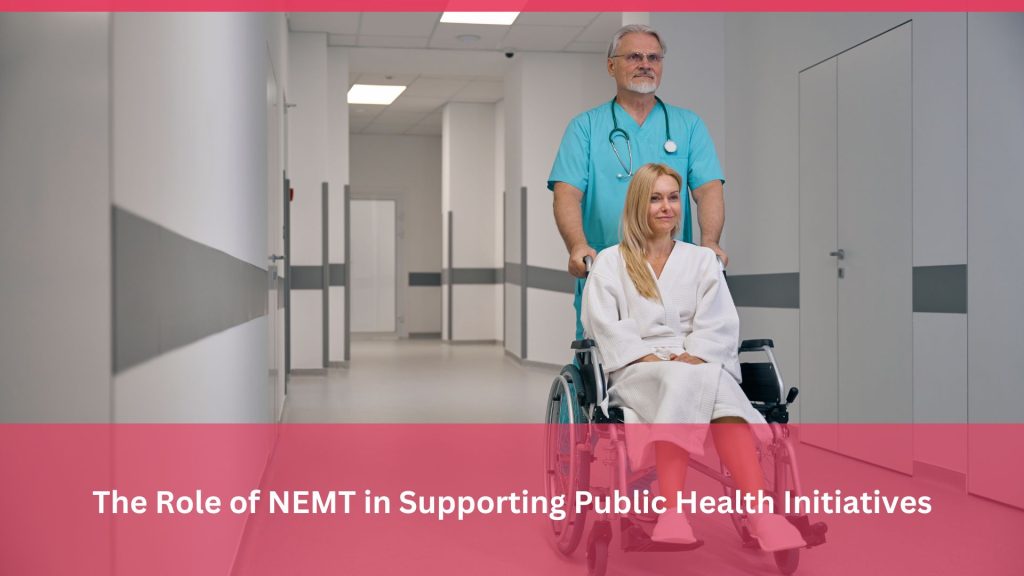New at Safr Care
The Role of NEMT in Supporting Public Health Initiatives

The Role of NEMT in Supporting Public Health Initiatives
Public health initiatives aim to safeguard and improve the wellbeing of entire communities, often focusing on preventive measures, vaccination drives, screening programs, and health education. However, many well-intentioned efforts fail to reach their full potential when individuals lack reliable transportation to these critical services. Non-Emergency Medical Transportation (NEMT) plays a pivotal role in bridging this gap, ensuring that people can participate in public health campaigns and maintain consistent access to medical resources. This article examines how NEMT enhances public health outcomes by facilitating preventive care, community engagement, and equitable healthcare access.
1. Enabling Access to Preventive Services and Screenings
Preventive care—such as routine vaccinations, blood pressure checks, and cancer screenings—significantly reduces morbidity and mortality rates. Unfortunately, low-income or rural communities often face logistical barriers that discourage consistent attendance at such programs. NEMT services address these issues by:
- Providing Door-to-Door Transport: Patients can reliably reach health fairs, community clinics, or screening events without depending on limited public transit.
- Coordinating Group Rides: Multiple individuals traveling from the same area can share one vehicle, improving efficiency and reducing no-shows.
- Offering Specialized Vehicles: Wheelchair-accessible or stretcher-equipped vans cater to people with mobility restrictions, allowing broader participation in preventive measures.
By simplifying travel, NEMT makes it easier for diverse populations to engage in early detection and disease prevention strategies.
2. Supporting Vaccination and Immunization Campaigns
Vaccination drives—whether seasonal flu shots, childhood immunizations, or pandemic-related immunizations—rely on widespread participation to achieve community immunity. NEMT services bolster these efforts by:
- Reducing Missed Appointments: Consistent, scheduled rides help patients keep vaccination times, crucial for multi-dose regimens.
- Facilitating Mobile Clinics and Pop-Ups: NEMT can transport individuals to temporary immunization sites in schools, community centers, or event halls.
- Minimizing Exposure Fears: Private, sanitized vehicles provide a safer travel alternative than crowded public transit, reassuring those concerned about infectious diseases.
This reliable network of rides contributes to higher vaccination rates, reinforcing the overall effectiveness of public health campaigns.
3. Enhancing Health Education and Outreach
Public health initiatives often include workshops, seminars, or group sessions that inform residents about nutrition, mental health, substance abuse prevention, or chronic disease management. NEMT services enable community members to participate in these programs by:
- Offering Transport to Health Workshops: People can attend learning sessions at libraries, community centers, or health departments without facing transit obstacles.
- Coordinating Multi-Stop Trips: Attendees can combine educational events with routine medical appointments or pharmacy visits, saving time and effort.
- Reaching Underserved Regions: NEMT providers can strategize routes that encompass rural or neglected neighborhoods, broadening outreach impact.
This improved engagement ensures that crucial public health messages and resources reach those who could benefit the most.
4. Reducing Strain on Emergency and Inpatient Services
Preventive and community-focused healthcare efforts are often more cost-effective than emergency interventions. However, without accessible transport, patients may wait until crises develop, driving up hospital visits and resource use. NEMT services address this issue by:
- Encouraging Early Intervention: Regular check-ups and screening participation lower the need for acute care or complex hospital treatments.
- Supporting Chronic Disease Management: With reliable rides, patients maintain steady follow-up appointments, stabilizing conditions before complications arise.
- Lowering Readmission Rates: Timely post-discharge transport ensures that patients attend follow-up appointments, reducing hospital readmissions.
This shift from reactive to proactive care not only improves individual health but also alleviates the burden on overwhelmed emergency facilities.
5. Fostering Health Equity and Community Well-Being
Transportation barriers disproportionately affect low-income families, rural populations, and communities of color, exacerbating existing health disparities. NEMT services help mitigate these inequalities by:
- Strengthening Underserved Areas: Reliable transport expands the reach of health programs into remote or financially constrained neighborhoods.
- Increasing Patient Confidence: Individuals feel more comfortable engaging with care providers when they know rides are secure and supportive.
- Boosting Community Resilience: By improving access to preventive care, the entire community becomes more prepared for public health emergencies or outbreaks.
In effect, NEMT serves as a cornerstone in reducing healthcare gaps, promoting a fair chance at good health for all community members.
Partnering with the Right NEMT Provider
To optimize the role of NEMT in public health initiatives, community organizations and healthcare systems should look for providers like SafrCare that emphasize:
- Skilled, Compassionate Drivers: Trained staff can assist diverse patients, including those with mobility devices or language barriers.
- Flexible Scheduling and Technology: Modern dispatch software, route optimization, and real-time tracking streamline outreach events and appointment arrivals.
- Collaborative Planning: Openness to coordinating with local health departments, clinics, or social service agencies ensures that transport aligns with community-wide health objectives.
Such collaborations reinforce the impact of public health strategies, bridging key gaps that hinder community wellness.
Conclusion
In the quest to elevate public health, reliable transportation can no longer be treated as an afterthought. From immunization campaigns to community health screenings and educational programs, NEMT services substantially broaden participation, ensuring no one is left behind due to transit constraints. By delivering specialized, compassionate, and flexible rides, NEMT providers help shift the focus from costly emergency care to proactive, preventive measures that keep communities healthier and more resilient.
When integrated into public health planning, NEMT stands as a transformative factor in reducing health disparities, empowering underserved populations, and promoting collective well-being. This collaboration between transport experts, healthcare professionals, and local agencies exemplifies how comprehensive, patient-centered solutions can pave the way for a healthier future for all.
